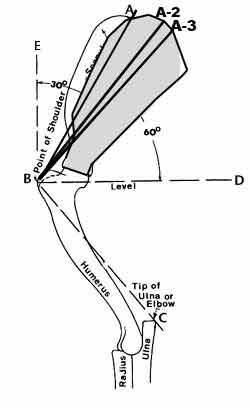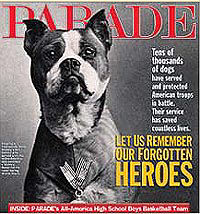By Dr. Scot E. Dowd
Our ideal APBT will move smoothly, powerfully, and effortlessly on a loose lead with the head extended at about 45 degrees to the body axis and tail either extended parallel to the ground or held slightly upright in challenge position (45 degrees to the ground). Reach and drive in the perfect movement will be ideally balanced front and rear. The rear foot will touch down in the exact spot the front foot has just occupied.
Research has shown that the best trotting dogs have an average shoulder layback of 28 degrees, plus or minus 5 degrees. At the extremes of shoulder layback, we have galloping dogs (sighthounds) which based upon their function, have steep layback to their shoulders (15-20 degrees), while diggers (such as Dachshunds) have greater layback at the opposite extreme (45-50).
APBTs, it must be emphasized are NOT designed as a typical trotting (gaiting) dog (show rings should not select for that perfect smooth gait) and should tend slightly more toward a greater layback than the perfectly smooth trotting breeds. A jaunty, confident, happy, springy gate combined with fluid grace. This is important because it also produces a more powerful gait that is wider with less convergence. The APBT should still converge more and more "toward the center line" as speed increases or there will be the tendency to have a rolling gait, which would be a fault. Thus, there is a fine balance between a smooth gaiting shoulder assembly and one designed for power AND speed. Recognizing this is vital for maintenance of working breed type.
The APBT standard calls for "well laidback shoulders". This is actually very descriptive especially considering that the breed is also "slightly longer than tall" as seen in a previous article, but the need for versatility and power indicate that the shoulder set should be a bit over a medium lay, which is usually around the sweet spot at 42 degrees such as is seen in the diagram below. We should certainly not allow the shoulder set to be less than the 32 degrees (gaiting layback) however, which would probably be a square dog that is capable of moving on the center line while trotting. In other words such an angle of the front assembly when combined with a square frame would move very smooth and graceful but would be opposed to many of the key features of APBT type. Judges must become a student of the breed movement rather than just having an eye for that textbook show gait. Hey don't negate Pat Hastings just realize that the APBT is not a "gaiting" breed. It is a wrestling breed (stability and stamina). Combining the terrier and the bull breeds produces stability, stamina, and agility.
When gaiting the APBT front assembly determines the amount of front end reach he will have. Remember There will not be excessive kick up in the rear, nor much vertical movement front or rear. From the side, the dog will appear to flow forward with long effortless smooth strides. The reach and drive between the front should be balanced with the rear and an optimal front reach would be reaching about to the tip of the muzzle and foot fall at speed would be just about at the point where the muzzle and head meet (stop) or at the jawline. A correct front structure will result (at least partially) in clean, correct and efficient front movement (Front movement is also determined by length of body and the balance or similarity between the dog's front and rear angulations as discussed below.)
The following characteristics are most vital to a good front structure:
Length of upper arm or humerus: As you can see from the diagram below, the dog's upper arm (humerus), should actually be slightly longer than the shoulder blade (scapula). Judges can assess length of upper arm by using three reference points that can be easily located. The top of the dog's shoulder (point A in the diagram below), the point of the shoulder (B) and the tip of the elbow (C). The common methodology used to do this measurement is performed by putting your thumb on the top of the withers A and stretching a finger down to the point of the shoulder B with one of your other fingers. Keeping your finger steady on B and the spacing or spread of your hand the same between your thumb and finger you then swing your thumb down to the tip of the elbow (C). The second distance measured -- B to C -- should be equal.
A structural problem where the upper arm is shorter than the scapula is becoming common in the APBT. In the figure this is where the measurement from B to C is shorter than B to A. This causes a particular movement fault typically resulting in less than optimal reach when moving and less than optimal convergence toward the centerline. This is also the typical structural defect noted when an APBT has a tendency for lifting the front feet too far off the ground with each stride. Remember the front feet should just clear the ground as the dog moves. Almost like the feet are gliding along the surface of the ground.
Head Carriage
Strong muscles, originating on the head and neck participate in movement by supplying lift to the scapulo-humeral joint. This is what gives the additional 10 to 15 degrees of rotation of the shoulder blade mentioned above when a dog has sufficient layback of shoulder. A dog with straight shoulders typically carries it's head head lower than a dog with good layback and may even carry it at the horizontal. This is so that these shoulder muscles have the leverage necessary to rotate the shoulder blade.
"Well laidback shoulders" provide better balanced support to the musculature - particularly and in support of the trapezius muscle. The trapezius is a large flat muscle, which connects the cervical vertebrae of the neck to the upper half of the scapula. The trapezius also connects the lower half of the scapula to the thoracic vertebrae.
Layback of shoulder: Judges can estimate shoulder layback by placing your forearm so that it passes through the point at the withers A and the point of the shoulder B and figuring the angle of that line (B-A) off the vertical (line E-B). Using this method, you can see that the dog in the diagram has a shoulder layback of 30 degrees which would be more than a bit upright for the APBT. The APBT standard calls for "well laid back shoulders" which is typically translated to mean closer to 45 degrees (I like at least 40 degrees). Dogs that are more square (compared to a dog such as the APBT which is slightly longer than tall) with good rear angulation typically have more upright shoulders to balance their structure and prevent their legs from interfering during the trot. Thus by selecting for square dogs with good movement and good angulations for instance you are probably selecting for more upright shoulders. The upright shoulder blade does not offer much support to the spinal column. As seen in our article on height and length the square dog are typically seen to have barely sufficient rear angulations, more upright shoulders, weakened support for the spinal column, and a tendency to converge overly much toward the centerline of balance.

Insufficient layback -- sometimes referred to as "a straight shoulders" -- is a widespread problem in APBT. When moving, dogs with insufficient layback typically do not move like a true APBT. Straight shoulders can also cause "too much" convergence toward the centerline. In a square dog with sufficient rear angulations and good balanced movement as seen from the side gait, you will often see too much convergence toward the centerline especially in the front assembly as the dog moves toward you. This is due to a straight shoulder in most cases. The graphic above to the left shows upright shoulders in the APBT. At 30oC this will produce a smooth moving dog that is more square rather than slightly longer. The graphic to the right shows "well laid back shoulders. Line A-2 indicates an almost ideal layback for the APBT line A-3 shows a bit too much lay back to the shoulders. Any degree between A and A-3 would be considered well-laid back.
Movement in the APBT, which converges to the centerline, is a fault according the APBT standard. The APBT standard indicates as speed increase convergence tends toward or "approaches the center line". Remember movement upon the centerline is characteristic of sighthounds such as Greyhounds or Whippets, who also typically have a more straight shoulder set. The APBT is an endurance breed but this does not at all mean endurance for galloping or full speed running. The APBT requires endurance at most tasks but especially according to their original purposes that task is typically wrestling. Thus endurance is more important functionally in relation to strength rather than speed, quickness of side to side movement rather than sprinting, lunging speed rather than coursing speed.
To continue to stress this important point, a medium between stability and speed, with a tendency toward stability, requires a bit more than moderate layback to the shoulders (well laid back). Insufficient layback at the shoulders can lead to other movement faults, especially if the rear is better angulated than the front -- a common problem -- causing the drive from the rear to be better than the reach in the front. The entire forequarters assembly works together to create that dreamlike movement of the APBT. That gliding gait that is smooth, yet springy, yet powerful, yet agile. All these words describe that ideal APBT movement.


